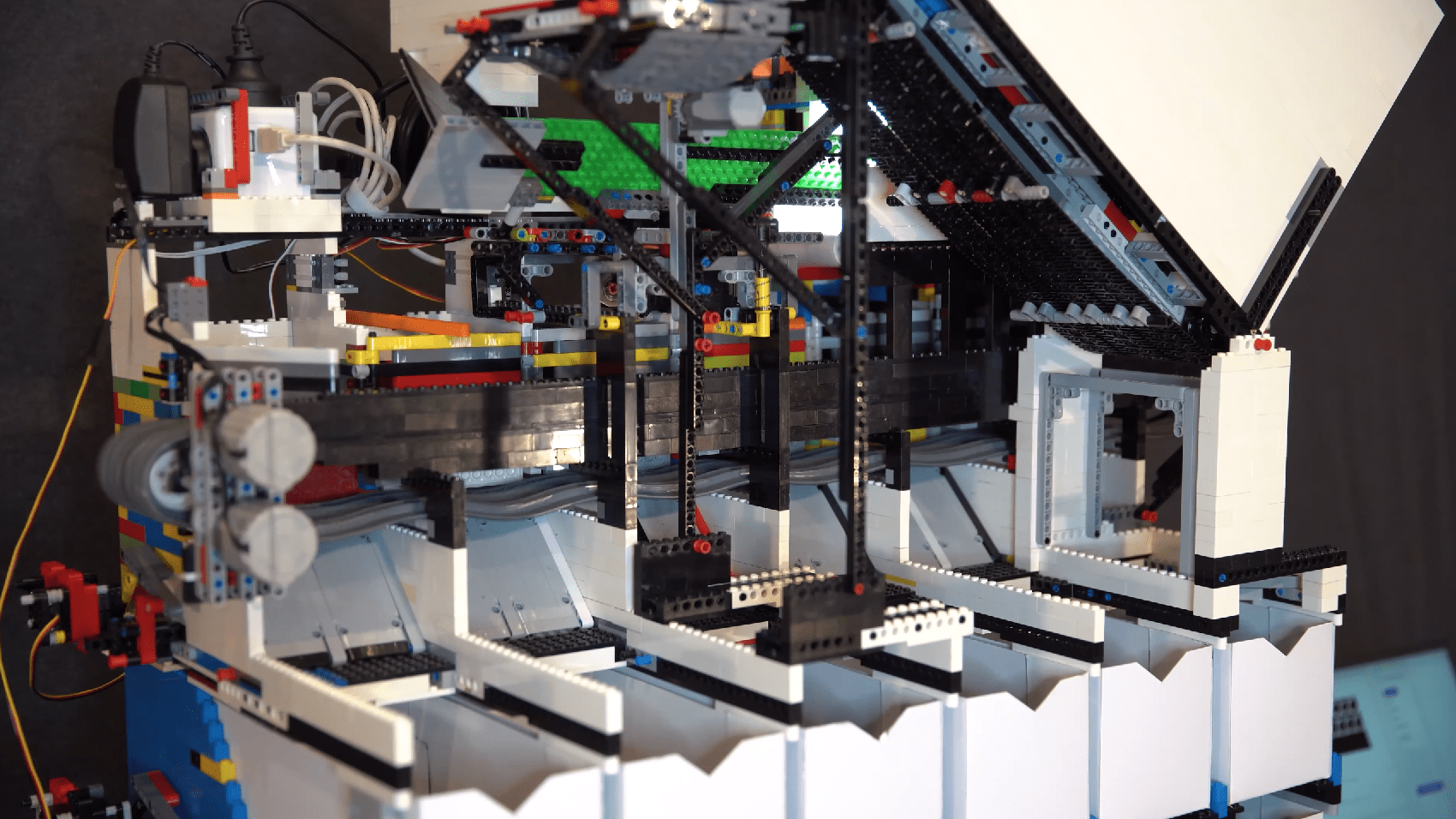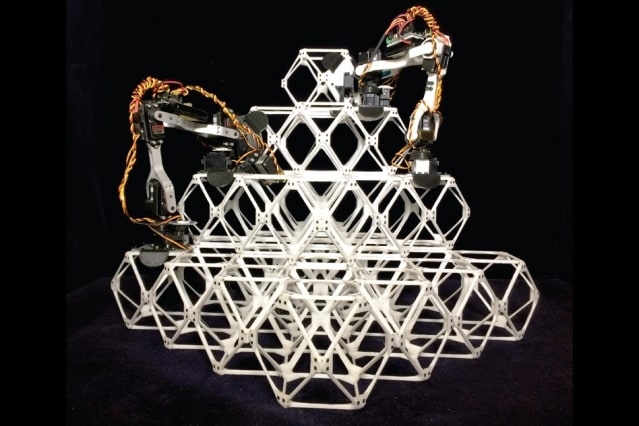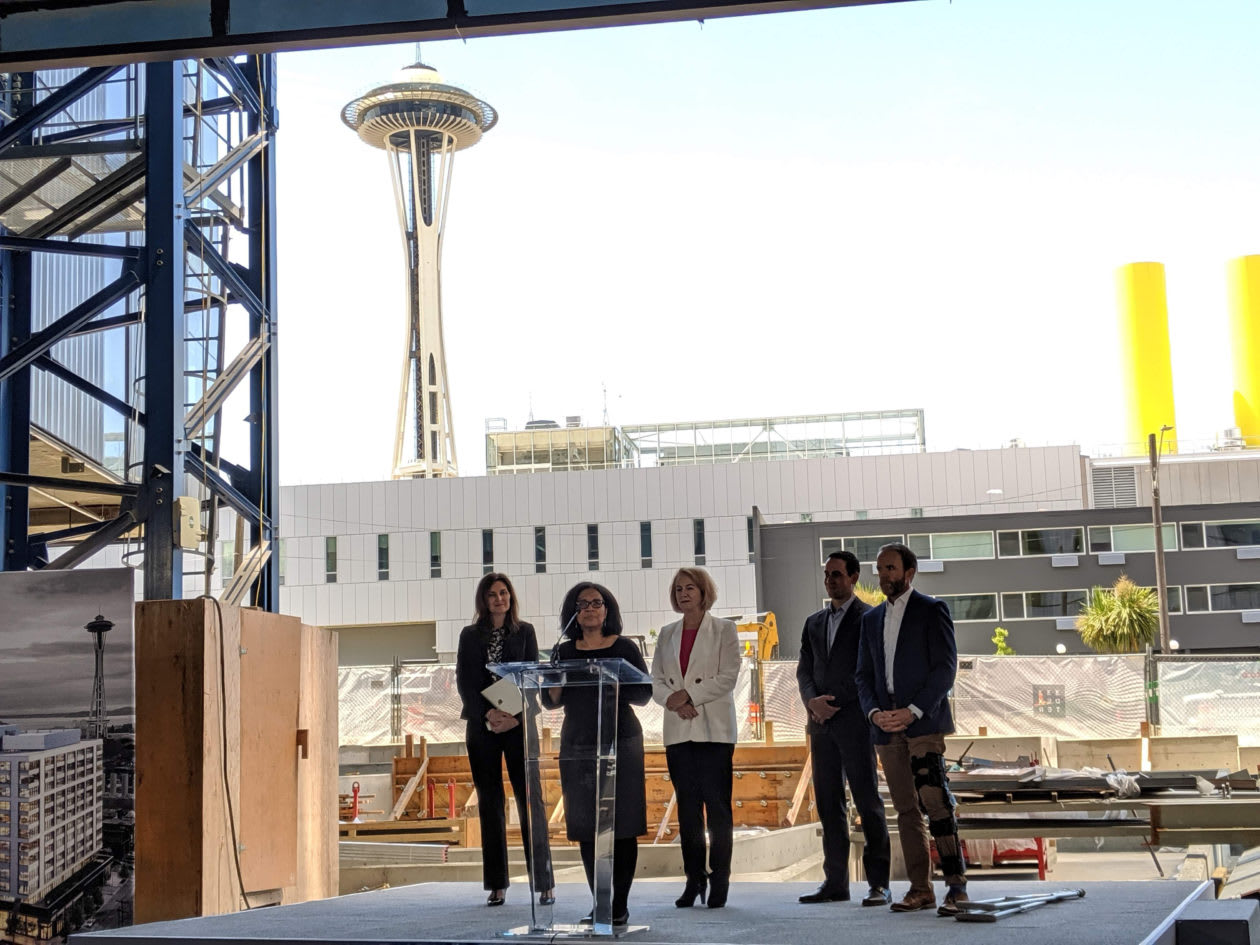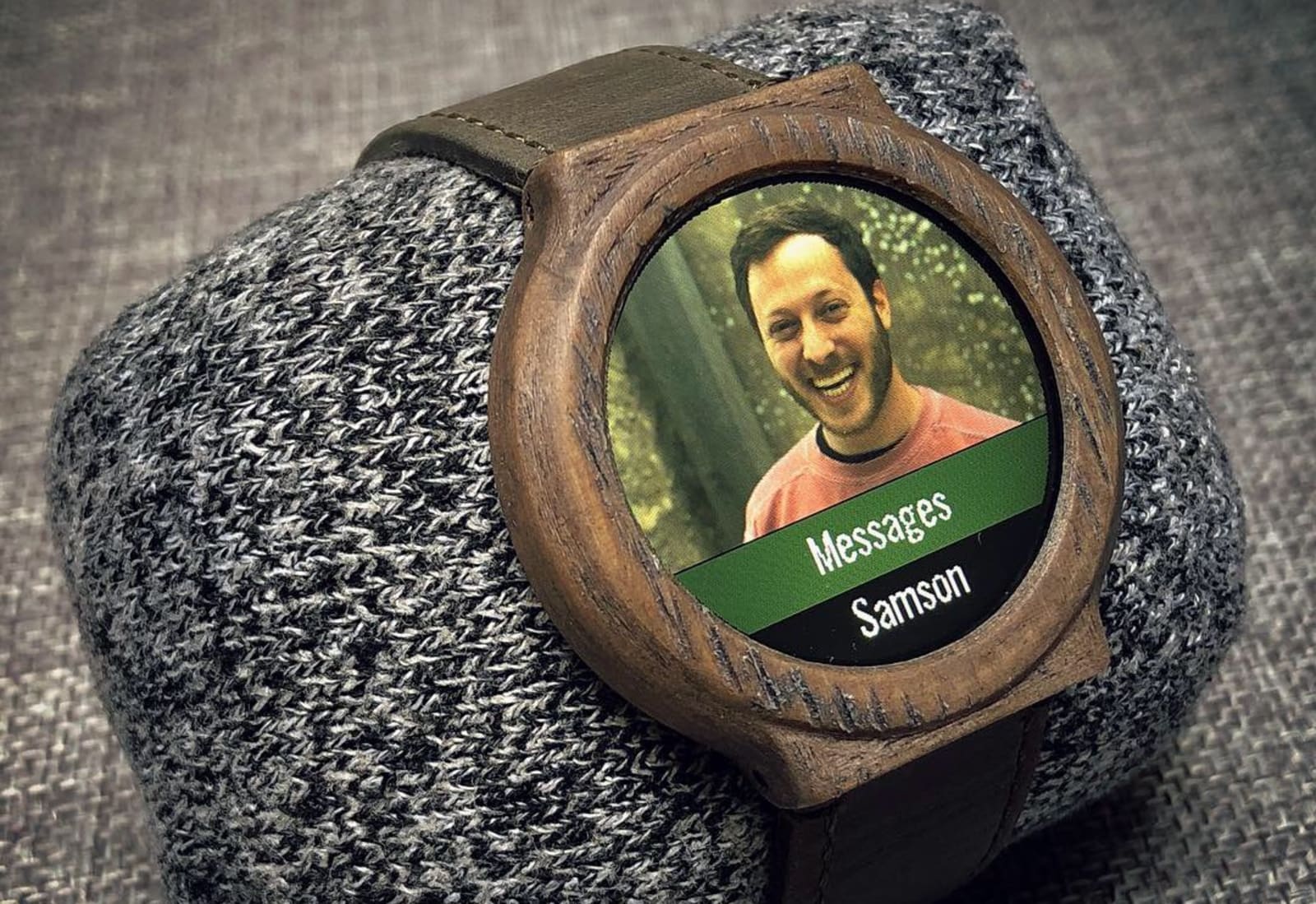Tag Archives: Engineering
Twisting Steel with LEGO Motors
LEGO bricks are some of the most awesome things on earth. They’re incredibly versatile for building all kinds of structures, and you can make some pretty impressive machines with them when you combine them with Technic and Mindstorms parts. I’ve always assumed that LEGO motors and gears aren’t particularly strong, but it turns out with the proper engineering, you can use them to bend and twist steel.

Brick Experiment Channel loves to create LEGO machines that show off their strength. He recently built a rig that uses a pair of LEGO Power Functions XL motors along with a number of gears to reduce their speed and increase their torque output. The result is a machine that that outputs 15 Newton meters (~11 lb-ft.) of torque, and is capable of taking a stainless steel axle and twisting it like a drill bit (or a Twizzler).
The builder’s ultimate goal was to see if he could actually break the steel rod before the LEGO parts would fail. By twisting the metal back and forth numerous times, he was ultimately able to introduce enough metal fatigue to to make the axle crack. It’s pretty amazing that this is possible, and looks like a fun science experiment for LEGO fans to try and replicate at home.
AI-powered Lego sorter knows the shape of every brick
 For some people, rummaging through a bunch of Lego bricks is part of the fun. But if you've got an enormous collection or take on complicated builds, you probably have a system for sorting your pieces. Your solution probably doesn't involve AI, thoug...
For some people, rummaging through a bunch of Lego bricks is part of the fun. But if you've got an enormous collection or take on complicated builds, you probably have a system for sorting your pieces. Your solution probably doesn't involve AI, thoug...
BILL-E is a cute robot that builds structures block by block
 A new robotics breakthrough could revolutionalize how we build everything from airplanes to bridges and even massive superstructures. A team of researchers at the Massachusettes Institute of Technology's Center for Bits and Atoms have created a new t...
A new robotics breakthrough could revolutionalize how we build everything from airplanes to bridges and even massive superstructures. A team of researchers at the Massachusettes Institute of Technology's Center for Bits and Atoms have created a new t...
This Robotic Thread Can Carefully Weave Itself Through Veins
While most robots use legs or wheels to move around, more and more robotic systems are adopting other kinds of locomotion. Some even wriggle around like snakes or worms. This worm-like robot is designed to maneuver through veins – which sounds scary, but could actually save lives.

Developed by a group of engineers at MIT, this extremely thin robot can make its way through twisty, turny, and narrow paths like the veins in your brain. The magnetic hyrdogel-coated robotic thread is actively-steered to its destination using a magnet to change its direction.
In theory, the tech could be used to build medical devices which smoothly wind their way through veins to perform procedures like clearing blood clots, and do it in a more controllable way than today’s techniques, which often use passive guidewires that work like a plumber’s snake, and can cause injury to delicate vessels and veins should they rub against their walls or catch a corner badly.
Toyota’s TILT Lab is a Maker Space for Manufacturing Ingenuity
I recently had the opportunity to visit Toyota’s largest vehicle production facility in the world, the Toyota Motor Manufacturing Kentucky (TMMK). While there, I not only got to see how humans and machines work together to make about 2000 cars per day, but learned a bit about the magicians who pull the strings behind the curtain of a car factory, the production engineering team. These are the brilliant minds who figure out how to take the designs and specifications for a vehicle and actually put it into production at the plant.

Production engineers must use their smarts and every resource available to come up with ways to build cars safely, quickly, within budget, on time, and with exceptional quality – all at very high volumes. This is no small task, and to help with their efforts, Toyota recently invested more than $80 million USD on a brand new Production Engineering and Manufacturing Center (PEMC), which houses the team right next door to the factory, and provides expansive floor spaces for testing out technologies and techniques for welding, plastics, painting, building powertrains before they hit the assembly line. In addition, it features a wonderful tool for empowering creativity and ingenuity – an on-site maker space known as the TILT Lab.

The 7,000 square foot facility is packed with modern tech that helps reinforce creativity and forward thinking, and currently has 27 pieces of equipment for rapid prototyping like laser and waterjet cutters, 3D printers, CNC milling machines, and more, and is staffed by a team of 10 technicians, engineers, designers, and interns.

Virtual reality and augmented reality tools are also on hand, and are also used for testing out new production techniques, as well as to visualize how parts might fit together on the line, or how production equipment might fit on the factory floor. This can save significant time and cost when it comes to moving from virtual reality to actual reality.

AR tech is also becoming an invaluable training tool, allowing students to practice and refine their production skills like welding and painting in a safe classroom environment. The TILT Lab is testing and refining these technologies, and seeing how they might be useful in a larger training setting.

There’s several pieces of high-end additive manufacturing gear on site, which allow engineers to rapidly fabricate prototypes of parts and tools that might be used in production. The machines on hand can print in a variety of materials, including hard and flexible plastics, and even carbon fiber reinforced plastic. I was especially impressed with their ability to print things like hoses that actually flex like the real deal, as well as multi-material parts.

In addition, there are two roomfuls of CNC machining and fabrication equipment, including a lathe, a mill, and a waterjet cutter for slicing through materials with ease. They also have a laser cutter/engraver, a powdercoating booth, a vinyl cutting machine, and plenty of power and hand tools on hand.


One of the niftier things the PEMC team has implemented is an authentication system which requires that users scan their badges to ensure they have the training required to use a particular piece of equipment before the machine can be used. They developed this application in-house, and it’s designed to ensure the safety of the team, as well as to protect the valuable equipment from damage. It’s even capable of paging an available team member with the proper training if the user needs help.

The TILT Lab is also experimenting with modern robot systems called “co-robotics.” These easy-to-program robots are designed to work side-by-side with humans, as they have sensors that make them aware of their surroundings, and can immediately react, slow down, or stop in the event that a person accidentally comes into contact with them. Traditional industrial robots have much more limited safeguards, and generally have to be kept behind safety enclosures to protect humans from injury.

I’ve been to a few publicly-available maker spaces over the years, and the equipment on hand at the TILT Lab is generally of a more professional grade than I’ve seen in those venues, plus it’s just awesome that it’s right on site next to the manufacturing facility. Backed by a talented operational team, the lab provides engineers with the best and latest technologies for improving operations at the factory next door, and at other Toyota plants around the globe.

Apple’s Seattle workforce will quintuple by 2024
 Apple is doubling down on the number of employees it plans on hiring in its new Seattle site. The company announced at a Monday news conference that it would be bringing 2,000 jobs to the city by 2024 -- twice the number it initially planned. The new...
Apple is doubling down on the number of employees it plans on hiring in its new Seattle site. The company announced at a Monday news conference that it would be bringing 2,000 jobs to the city by 2024 -- twice the number it initially planned. The new...
An engineer allegedly falsified inspection reports for SpaceX rockets
 Federal investigators believe a quality assurance engineer responsible for inspecting parts for SpaceX had been falsifying reports. The accused engineer works for New York-based PMI Industries and is accused of forging signatures on at least 38 inspe...
Federal investigators believe a quality assurance engineer responsible for inspecting parts for SpaceX had been falsifying reports. The accused engineer works for New York-based PMI Industries and is accused of forging signatures on at least 38 inspe...
This guy built his own smartwatch and so can you
 DIY projects can be a lot of fun, and if Raspberry Pi has taught us anything it's that people love to tinker. But for most folk, forays into the world of build-it-yourself tech start and end with a specific kit and a whole bunch of instructions to he...
DIY projects can be a lot of fun, and if Raspberry Pi has taught us anything it's that people love to tinker. But for most folk, forays into the world of build-it-yourself tech start and end with a specific kit and a whole bunch of instructions to he...
These Wheels Shapeshift for Different Terrain
Who says wheels need to just be round? These unusual Reconfigurable-Wheel Track (RWT) wheels were developed by CMU National Robotics Engineering Center for DARPA’s Ground X-Vehicle Technologies program.
We can expect to see these on the war machines of the future and they may be the next step toward real-life Transformers like Optimus Prime.

These wheels can morph from a round wheel to a triangular treaded track quickly, in less than a second, which makes the vehicle good for a wide variety of terrains. The round wheels are good for hard surfaces, while the triangular tracked wheel is good for softer ones.
It’s pretty impressive to see the wheels in action. I’m hope we see them on more military vehicles very soon, then one day hopefully our own civilian vehicles will have them as well. There’s certainly more that can go wrong with these wheels compared to what we are using now, but they provide a lot more benefits too.
It’s just a shame that they only show them working on a paved parking lot. I’d like to see how they perform and change while on softer ground. This makes me think that they may not be ready for prime time.
[via Geekologie]